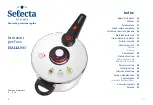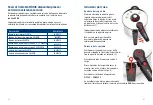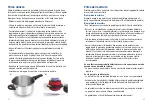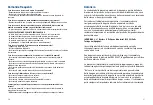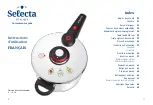
31
30
Finish cooking
To depressurize the pressure cooker turn the
Pressure Valve slowly and incrementally to the
release position. Steam will loudly escape from
the pressure cooker through the valve, so be
careful to keep your hands away from the top of
the valve, or use an oven mitt for protection.
To reduce the pressure quicker, you can cool down
the pressure cooker by pouring a small stream of
cold water on the lid.
• Only when there is no pressure inside the pressure
cooker, you can proceed to open the lid.
• Opening it with pressure inside can cause injury.
• Use the handles when moving the pressure cooker.
If you cannot open the pressure cooker lid:
• Depressurize the cooker and remove the operating valve.
• Ensure that there is no more pressure inside.
If the foods aren’t cooked or have been burned, verify:
• The cooking time used.
• The level of heat is enough.
• The correct placement of the operating valve.
• The amount of water used.
Cleaning & maintenance
Avoid leaving foods inside the pressure cooker for long periods of time.
NEVER use bleach or products which contain hydrochloric compounds.
• Before each use, clean the cooker with the help of warm water and a
soft soaps.
• To wash the inside of the body of the cooker, you can use a soft soap
and an ordinary scouring pad.
• To wash the exterior of the body of the cooker, you can use a soft
detergent and an ordinary scouring pad on its soft side.
• To wash the pressure cooker lid, you can use a soft detergent and an
ordinary scouring pad on its soft side.
• You can wash the body of the pressure cooker by hand or in the dishwasher.
Do not leave the pressure cooker lid soaked in water.
Do not wash the pressure cooker lid in the dishwasher.
• Clean regularly the operating valve.
• Clean the base of the safety valve on the inside of the cooker lid.
Storage
• Turn the pressure cooker lid over and place it on top of the cooker body.
• Avoid leaving cooked foods in the cooker for long periods of time, as
they tend to get stuck. This can lead into having to clean with more
aggressive detergents and scouring pads the pressure cooker in
order to get rid of the stuck dirt resulting in a possible damage of your
cookware.
• Limescale marks can be avoided by drying the pressure cooker with
a dry cloth instead of leaving it to dry itself. This way we also avoid the
marks left by the chlorine and other substances the water contains.
• If we have a particularly stubborn mark we can rub the pressure cooker
with a cloth soaked in hot vinegar. After that, proceed to a normal
washing and drying of the pressure cooker.
• If the pressure cooker has lost its shine, we can polish the pressure
cooker body with a cloth soaked in alcohol.
Changing the silicone gasket
• Always choose the silicone gasket corresponding to the correct pressure
cooker model.
• Soak the silicone gasket in soapy water, rinse it off and place it applying
some pressure with the fingers until the seal fits perfectly with the inside
edge of the pressure cooker lid.
• Never cut the silicone gasket.
Make your pressure cooker is revised by an authorized MONIX service if it
has not been in use for more than 10 years.
In case you have burned foods inside the pressure cooker:
• Leave the pressure cooker body soaked in warm and soapy water before
starting to clean it.

















